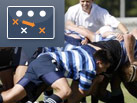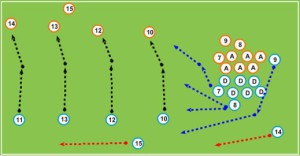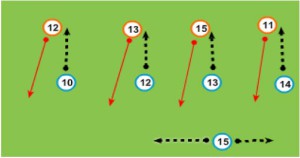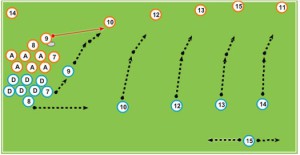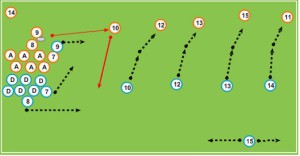
|
In our latest series of Technical Zone articles, Greg Commins looks at the four possible threats the defending team needs to cover when defending from the scrum:
Cut back inside from an attacking player can be devastating for a defending team if their lines are not solid and working together. Why I say this is because it is the second quickest way to cross the advantage line after the 8 pick and go and when an attacker is behind the defense without a line to cut him off there is trouble!
To ensure this does not happen a team needs to start off by lining up correctly at scrum time and this differs from the left and right hand side. The major factor is that the defending #9 will either be standing on the open ( L ) or blind side ( R ).
|
|
If the scrum is on the left hand side for the defending team, #9 should be aiming to cover the opposing #10 which creates what is called ‘ONE OUT DEFENSE’ where every player bumps one out. This will create an extra man in defense usually the #15 which will allow him to cover the back watching for the kick and line break.
Behind and inside of #9 the defending open side flanker #7 is pushing up watching for a miss tackle by #9 which can be caused by the cut back which often happens as strong inside centers can step and bust inside. A third man in defense can be the defending #8 who can wait to see the ball’s movement and if it is coming back inside he can be waiting just off the base as he will be working across in a lateral line of defense.
Two very important points to make this LEFT defense work:
1. The defending #9 must not get into the pocket between the opposition loose forwards (Pic A)
2. Every defender must work up then out to shut down the space inside or they will expose their inside (Pic B).
Pic A – #9 getting caught in the pocket taking himself out of the defense line causing a hole in the 10’s channel for a cut back switch by attacking #10 & #12 or a simple inside break by attacking #10 |
|
Pic B – Incorrect defensive lines from the outside backs showing the inside shoulder exposed for a cut back.
|
|
Defending Right Hand Side:
|
|
If the scrum is on the right hand side for the defending team the ‘MAN ON MAN’ defense needs to be adopted not the ‘ONE OUT’ as the defending #9 is now blind side and unable to assist with channel defense. Players needs to mark up on their opposite number and the #15 needs to sweep behind watching for the kick or the opposite #15 insertion.
To eliminate the cut back threat the defending open side flanker should work up and out similar to the #9’s defense line from the left and #8 should read the play, if it goes wide he should push out, but if it comes back inside he should be there to assist. Defending #9 must not follow the ball around the scrum as this will take him out of the game, #9 needs to back track and sweep across behind the backline covering the line break or kick. Blind side wing should also be alert and also work to assist if there is a line break or a kick, the defense system should be:
In closing, the key to making this work is communication every player needs to have their team mates talking inside and outside of them so everyone knows where their support is. If a player does not hear his support he will stall to check and this creates holes. Practice, practice, practice as this creates confidence and players can learn how to work with each other. |

